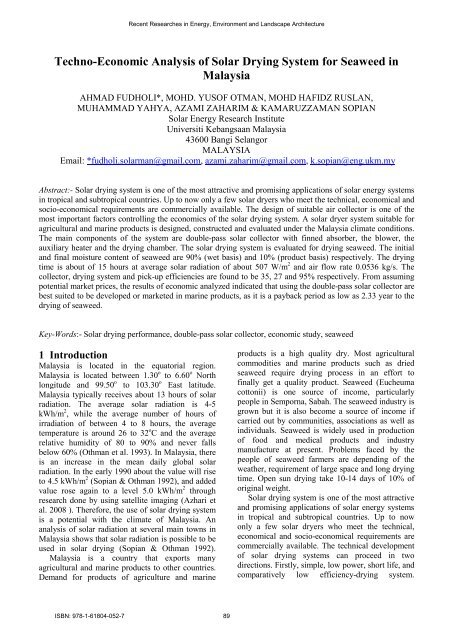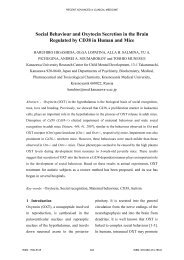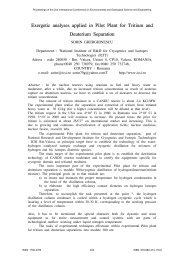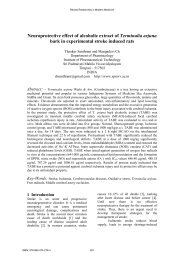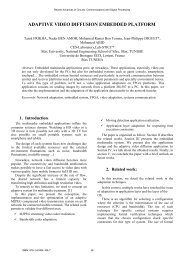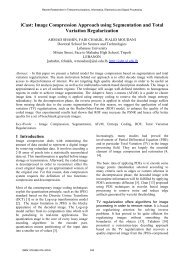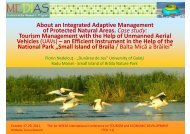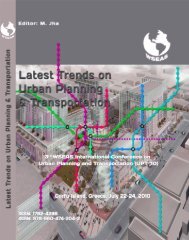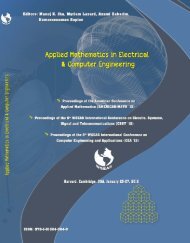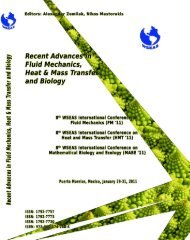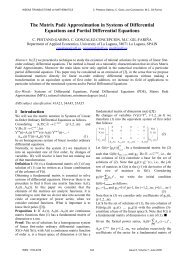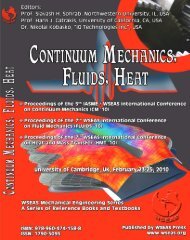Techno-Economic Analysis of Solar Drying System for ... - Wseas.us
Techno-Economic Analysis of Solar Drying System for ... - Wseas.us
Techno-Economic Analysis of Solar Drying System for ... - Wseas.us
You also want an ePaper? Increase the reach of your titles
YUMPU automatically turns print PDFs into web optimized ePapers that Google loves.
<strong>Techno</strong>-<strong>Economic</strong> <strong>Analysis</strong> <strong>of</strong> <strong>Solar</strong> <strong>Drying</strong> <strong>System</strong> <strong>for</strong> Seaweed in<br />
Malaysia<br />
AHMAD FUDHOLI*, MOHD. YUSOF OTMAN, MOHD HAFIDZ RUSLAN,<br />
MUHAMMAD YAHYA, AZAMI ZAHARIM & KAMARUZZAMAN SOPIAN<br />
<strong>Solar</strong> Energy Research Institute<br />
Universiti Kebangsaan Malaysia<br />
43600 Bangi Selangor<br />
MALAYSIA<br />
Email: *fudholi.solarman@gmail.com, azami.zaharim@gmail.com, k.sopian@eng.ukm.my<br />
Abstract:- <strong>Solar</strong> drying system is one <strong>of</strong> the most attractive and promising applications <strong>of</strong> solar energy systems<br />
in tropical and subtropical countries. Up to now only a few solar dryers who meet the technical, economical and<br />
socio-economical requirements are commercially available. The design <strong>of</strong> suitable air collector is one <strong>of</strong> the<br />
most important factors controlling the economics <strong>of</strong> the solar drying system. A solar dryer system suitable <strong>for</strong><br />
agricultural and marine products is designed, constructed and evaluated under the Malaysia climate conditions.<br />
The main components <strong>of</strong> the system are double-pass solar collector with finned absorber, the blower, the<br />
auxiliary heater and the drying chamber. The solar drying system is evaluated <strong>for</strong> drying seaweed. The initial<br />
and final moisture content <strong>of</strong> seaweed are 90% (wet basis) and 10% (product basis) respectively. The drying<br />
time is about <strong>of</strong> 15 hours at average solar radiation <strong>of</strong> about 507 W/m 2 and air flow rate 0.0536 kg/s. The<br />
collector, drying system and pick-up efficiencies are found to be 35, 27 and 95% respectively. From assuming<br />
potential market prices, the results <strong>of</strong> economic analyzed indicated that <strong>us</strong>ing the double-pass solar collector are<br />
best suited to be developed or marketed in marine products, as it is a payback period as low as 2.33 year to the<br />
drying <strong>of</strong> seaweed.<br />
Key-Words:- <strong>Solar</strong> drying per<strong>for</strong>mance, double-pass solar collector, economic study, seaweed<br />
1 Introduction<br />
Malaysia is located in the equatorial region.<br />
Malaysia is located between 1.30 o to 6.60 o North<br />
longitude and 99.50 o to 103.30 o East latitude.<br />
Malaysia typically receives about 13 hours <strong>of</strong> solar<br />
radiation. The average solar radiation is 4-5<br />
kWh/m 2 , while the average number <strong>of</strong> hours <strong>of</strong><br />
irradiation <strong>of</strong> between 4 to 8 hours, the average<br />
temperature is around 26 to 32 o C and the average<br />
relative humidity <strong>of</strong> 80 to 90% and never falls<br />
below 60% (Othman et al. 1993). In Malaysia, there<br />
is an increase in the mean daily global solar<br />
radiation. In the early 1990 about the value will rise<br />
to 4.5 kWh/m 2 (Sopian & Othman 1992), and added<br />
value rose again to a level 5.0 kWh/m 2 through<br />
research done by <strong>us</strong>ing satellite imaging (Azhari et<br />
al. 2008 ). There<strong>for</strong>e, the <strong>us</strong>e <strong>of</strong> solar drying system<br />
is a potential with the climate <strong>of</strong> Malaysia. An<br />
analysis <strong>of</strong> solar radiation at several main towns in<br />
Malaysia shows that solar radiation is possible to be<br />
<strong>us</strong>ed in solar drying (Sopian & Othman 1992).<br />
Malaysia is a country that exports many<br />
agricultural and marine products to other countries.<br />
Demand <strong>for</strong> products <strong>of</strong> agriculture and marine<br />
Recent Researches in Energy, Environment and Landscape Architecture<br />
ISBN: 978-1-61804-052-7 89<br />
products is a high quality dry. Most agricultural<br />
commodities and marine products such as dried<br />
seaweed require drying process in an ef<strong>for</strong>t to<br />
finally get a quality product. Seaweed (Eucheuma<br />
cottonii) is one source <strong>of</strong> income, particularly<br />
people in Semporna, Sabah. The seaweed ind<strong>us</strong>try is<br />
grown but it is also become a source <strong>of</strong> income if<br />
carried out by communities, associations as well as<br />
individuals. Seaweed is widely <strong>us</strong>ed in production<br />
<strong>of</strong> food and medical products and ind<strong>us</strong>try<br />
manufacture at present. Problems faced by the<br />
people <strong>of</strong> seaweed farmers are depending <strong>of</strong> the<br />
weather, requirement <strong>of</strong> large space and long drying<br />
time. Open sun drying take 10-14 days <strong>of</strong> 10% <strong>of</strong><br />
original weight.<br />
<strong>Solar</strong> drying system is one <strong>of</strong> the most attractive<br />
and promising applications <strong>of</strong> solar energy systems<br />
in tropical and subtropical countries. Up to now<br />
only a few solar dryers who meet the technical,<br />
economical and socio-economical requirements are<br />
commercially available. The technical development<br />
<strong>of</strong> solar drying systems can proceed in two<br />
directions. Firstly, simple, low power, short life, and<br />
comparatively low efficiency-drying system.
Secondly, high efficiency, high power, long life<br />
expensive drying system (Fudholi et al. 2010). The<br />
solar drying system consist collector, assisted<br />
heater, blower and drying chamber. The design <strong>of</strong><br />
suitable air collectors is one <strong>of</strong> the most important<br />
factors controlling the economics <strong>of</strong> the solar<br />
drying. To date, flat plate solar collectors are widely<br />
<strong>us</strong>ed. This study is techno-economic <strong>of</strong> a solar<br />
assisted drying system <strong>us</strong>ing double-pass solar<br />
collector with finned absorbers.<br />
2 Material and Methods<br />
The experiment is carried out at the Green Energy<br />
<strong>Techno</strong>logy Innovation Park, Universiti Kebangsaan<br />
Malaysia.<br />
2.1 Description <strong>of</strong> <strong>Solar</strong> <strong>Drying</strong> <strong>System</strong><br />
The solar assisted <strong>for</strong>ced convection drying system<br />
is installed at the Green Energy <strong>Techno</strong>logy<br />
Innovation Park, Universiti Kebangsaan Malaysia.<br />
This drying system is capacity <strong>of</strong> drying 300 kg<br />
seaweed. Fig. 1 shows the schematic diagram <strong>of</strong> the<br />
solar drying system. The main components are solar<br />
collector array (Fig. 2), auxiliary heater, blower, and<br />
drying chamber. The size <strong>of</strong> the chamber is 4.8 m in<br />
length, 1 m width and 0.6 m in height. The<br />
collectors are the double-pass finned collector. The<br />
four collectors are set in series. The double-pass<br />
finned collector efficiency is about <strong>of</strong> 45-77%<br />
(Fudholi et al., 2011)<br />
Air<br />
inlet<br />
Auxiliary<br />
heater<br />
Double-pass<br />
solar collector<br />
Blower<br />
<strong>Drying</strong><br />
chamber<br />
Fig. 1. Schematic diagram <strong>of</strong> solar drying system<br />
The collector width and length were 1.2 m and 4.8<br />
m respectively. The solar collector array consists <strong>of</strong><br />
4 solar collectors. The upper channel depth is 3.5<br />
cm and the lower depth is 7 cm. The bottom and<br />
Recent Researches in Energy, Environment and Landscape Architecture<br />
ISBN: 978-1-61804-052-7 90<br />
sides <strong>of</strong> the collector have been insulated with<br />
2.5cm thick fiberglass to minimize heat losses.<br />
Upper air<br />
flow<br />
Lower<br />
air flow<br />
Inlet air Inlet air<br />
Outlet air<br />
Fig. 2. The collector arrangement <strong>for</strong> the solar<br />
drying system<br />
Fig. 3 shows the cross section <strong>of</strong> the collector<br />
with the aluminium plate fins. The collector consists<br />
<strong>of</strong> the glass cover, the insulated container and the<br />
black painted aluminium absorber. The size <strong>of</strong> the<br />
collector is 1.2 m wide and 4.8 cm long. In this type<br />
<strong>of</strong> collector, the air initially enters through the first<br />
channel <strong>for</strong>med by the glass covering the absorber<br />
plate and then through the second channel <strong>for</strong>med<br />
by the back plate and the finned absorber plate.<br />
Glass cover<br />
Air inlet<br />
Air outlet<br />
Insulation<br />
Absorber plate<br />
Fins<br />
Fig. 3. The schematic <strong>of</strong> a double-pass solar<br />
collector with finned absorber<br />
Table 1. Key parameters <strong>of</strong> the solar drying system<br />
Parameters Unit Value<br />
Collector area m 2 11.52<br />
<strong>Drying</strong> chamber area m 2 4.8<br />
Capacity <strong>of</strong> dryer kg 250-300<br />
Mass flow rate<br />
Average temperature <strong>of</strong><br />
kg/s 0.05-0.12<br />
drying chamber<br />
o<br />
C 40-65
2.2. Method<br />
Experiment done begins at 08:00 am that day at<br />
06:00 pm, which begins when the data was taken<br />
from 09:00 am to 05:00 pm. The next day continued<br />
and dryer stopped drying after heavy achieved<br />
continuo<strong>us</strong>. The data measured are air temperature<br />
(ambient temperature, air temperature inlet and<br />
outlet <strong>of</strong> the collector), radiation intensity and air<br />
velocity, also measured the air temperature be<strong>for</strong>e it<br />
enters the dryer chamber, the temperature inside the<br />
dryer chamber, the temperature <strong>of</strong> the air out <strong>of</strong> the<br />
dryer chamber and wet bulb temperature and dry<br />
bulb temperature <strong>of</strong> the air out <strong>of</strong> the dryer chamber.<br />
Air temperature was measured by T-type<br />
thermocouple is then recorded in a data acquisition<br />
system. The intensity <strong>of</strong> solar radiation measured by<br />
pyranometer and measurement data recorded in a<br />
computer.<br />
3 Data <strong>Analysis</strong><br />
3.1 Estimating <strong>of</strong> <strong>Drying</strong> Time<br />
<strong>Solar</strong> drying system is tested <strong>for</strong> drying <strong>of</strong> seaweed.<br />
The average solar radiation 500 W/m 2 , the<br />
experiment data as follow:<br />
1. <strong>Drying</strong> air conditions be<strong>for</strong>e entering the<br />
collection are:<br />
Dry bulb temperature <strong>of</strong> 30 o C and wet bulb<br />
temperature <strong>of</strong> 28 o C<br />
2. <strong>Drying</strong> air flow rate = 0.053 kg/s<br />
3. Average temperature <strong>of</strong> drying chamber = 60 o C<br />
For 40 kg seaweed, water m<strong>us</strong>t be evaporated is<br />
35.56 kg. From the psychometric chart in Fig. 4<br />
obtained:<br />
35 o C<br />
28 o C<br />
A<br />
C<br />
RH = 100%<br />
RH = 85% RH = 20%<br />
B<br />
30 o C 60 o C<br />
Dry bulb temperature ( o C)<br />
Moisture<br />
content<br />
(kg/kg dry air)<br />
0.035<br />
0.022<br />
Fig. 4. Simple psychometric chart <strong>of</strong> drying process<br />
Recent Researches in Energy, Environment and Landscape Architecture<br />
ISBN: 978-1-61804-052-7 91<br />
where,<br />
A : ambient air<br />
B : inlet air to drying chamber<br />
C : outlet air to drying chamber<br />
AB: air heating from solar collector<br />
BC: drying process<br />
For 100 kg seaweed, water m<strong>us</strong>t be evaporated is<br />
about 89 kg, with temperature <strong>of</strong> drying chamber<br />
about 50 o C obtained:<br />
(i) The time <strong>of</strong> drying = 23.35 hours (24 hours)<br />
or 3 drying day.<br />
(ii) Evaporation capacity = 0.009 x 0.12 x 3600<br />
= 3.89 kg/h<br />
(iii) Water that can evaporated <strong>for</strong> 1 kg <strong>of</strong> dry air<br />
= (0035-0022) = 0.013 kg/kg<br />
(iv) Dry air required <strong>for</strong> drying = 35.56/0.013 =<br />
2735.38 kg<br />
(v) The air dryer required = 2735.38 (1.02) =<br />
2790.09 kg<br />
(vi) The time <strong>of</strong> drying = 2790.09/ (0.0536)<br />
(3600) = 14.46 hours (15 hours) or 2 drying<br />
day.<br />
(vii) Evaporation capacity = 0.013 x 0.0536 x<br />
3600 = 2.48 kg/h<br />
3.2 Estimating <strong>of</strong> Per<strong>for</strong>mance <strong>Solar</strong> <strong>Drying</strong><br />
<strong>System</strong><br />
The efficiency <strong>of</strong> a solar collector is the ratio <strong>of</strong><br />
<strong>us</strong>eful heat gain to the solar radiation incident on the<br />
plane <strong>of</strong> the collector. It is defined as (Fudholi et al.,<br />
2011)<br />
mC(<br />
To<br />
− Ti<br />
)<br />
η c =<br />
x100%<br />
(1)<br />
AcS<br />
where,<br />
m = mass flow rate (kg/s)<br />
C = specific heat <strong>of</strong> air (J kg -1 o C -1 )<br />
Ac = collector area (m 2 )<br />
Ti = inlet air temperature ( o C)<br />
To = outlet air temperature ( o C)<br />
S = solar radiation intensity (W/m 2 )<br />
<strong>System</strong> drying efficiency is defined as the ratio<br />
<strong>of</strong> the energy required to evaporate the moisture to<br />
the heat supplied to the drier. For the solar collector<br />
the heat supplied to the drier is the solar radiation<br />
incident upon the solar collector. The system drying<br />
efficiency is a measure <strong>of</strong> the overall effectiveness<br />
<strong>of</strong> drying systems (Supranto et al. 2009). For <strong>for</strong>ce<br />
convection dryer, typical, values are expected. The<br />
system efficiency <strong>for</strong> <strong>for</strong>ced convection solar dryers<br />
need to take into account the energy consumed by<br />
fan/blower. The following relation is then <strong>us</strong>ed<br />
(Leon et al., 2002)
WL<br />
η p =<br />
(2)<br />
IA + P<br />
c<br />
f<br />
where,<br />
W = weight <strong>of</strong> water evaporated from the product<br />
(kg)<br />
L = latent heat <strong>of</strong> vaporisation <strong>of</strong> water at exit air<br />
temperature (J/kg)<br />
Pick-up efficiency determines the efficiency <strong>of</strong><br />
moisture removal by the drying air from the product<br />
(Leon et al., 2002).<br />
h0<br />
− hi<br />
W<br />
η p = =<br />
(3)<br />
h − h vρt<br />
h − h<br />
where,<br />
as<br />
i<br />
( )<br />
ho = Absolute humidity <strong>of</strong> air leaving the drying<br />
chamber (%)<br />
hi = Absolute humidity <strong>of</strong> air entering the drying<br />
chamber (%)<br />
has = Absolute humidity <strong>of</strong> the air entering the dryer<br />
at the point <strong>of</strong> adiabatic saturation (%)<br />
v = volumetric airflow (m 3 /s)<br />
ρ = density <strong>of</strong> air (kg/m 3 )<br />
t = drying time (s)<br />
3.3 <strong>Economic</strong>s <strong>Analysis</strong><br />
Capital costs (FC) solar drying system installed cost<br />
is the sum <strong>of</strong> all the components as collector, drying<br />
chamber, blower, the auxiliary heater, and<br />
distribution system and installation costs. The cost<br />
<strong>of</strong> drying (products) can be divided into fixed costs<br />
and direct costs. Direct costs comprise costs <strong>of</strong> fresh<br />
materials, labor cost control, electrical, maintenance<br />
and insurance. The cost <strong>of</strong> the product can be<br />
written as follows (Yahya 2007)<br />
PC = MTC + LBC + ELC + EC (4)<br />
where<br />
EXC = MC + IC (5)<br />
with<br />
PC = production cost<br />
MTC = cost <strong>of</strong> fresh materials<br />
LBC = labor costs<br />
ELC = electricity costs<br />
MC = maintenance cost<br />
IC = cost <strong>of</strong> insurance<br />
Recent Researches in Energy, Environment and Landscape Architecture<br />
as<br />
ISBN: 978-1-61804-052-7 92<br />
i<br />
Table 2. Estimated cost <strong>of</strong> components <strong>of</strong> solar<br />
drying system<br />
No Components/ Parameters Cost (RM)<br />
1<br />
Double-pass solar collector<br />
with finned absorber 15000<br />
2 Ducting system 250<br />
3 Blower 1600<br />
4 Auxiliary heater 1200<br />
Distribution system and<br />
5 installation 10000<br />
Flooring and drying<br />
6 chamber 4000<br />
Total capital cost 32050<br />
The per<strong>for</strong>mance <strong>of</strong> an investment can be studied<br />
from the production. Pr<strong>of</strong>it is defined as the<br />
difference between total sales (PP) with all types <strong>of</strong><br />
spending. Pr<strong>of</strong>its can be written as (Yahya 2007)<br />
PR = PP – FC – PC (6)<br />
Return <strong>of</strong> capital is also called the pr<strong>of</strong>it from the<br />
investment and is influenced by time, can be written<br />
as (Yahya 2007)<br />
PR<br />
ROR = (7)<br />
FC<br />
Simple Payback (SPB) is the investment cost per<br />
average annual net income. Returns are easy to<br />
recover the invested capital. SPB is calculated as<br />
(Fudholi 2006):<br />
FC<br />
SPB = (8)<br />
PR<br />
Parameters <strong>of</strong> the rate <strong>of</strong> return <strong>of</strong> capital and the<br />
payback period are not easy to take into account the<br />
impact on value <strong>for</strong> money. While the net present<br />
value method (NPV) is calculating the present value<br />
<strong>of</strong> excess cash flow during the project period. NPV<br />
is the total present value <strong>for</strong> each year <strong>of</strong> the net<br />
cash flow less capital costs. It is calculated as<br />
follows (Fudholi 2006)<br />
N<br />
∑<br />
n=<br />
1<br />
n<br />
NPV = P (1+<br />
i) - FC<br />
(9)<br />
n<br />
Where,<br />
−<br />
P = S 1 + i<br />
(10)<br />
n<br />
( ) n<br />
Where, Pn is the discounted present value (S) to<br />
be invested in the n years in the future. Investment<br />
is a positive NPV will be selected.
4 Results and Disc<strong>us</strong>sion<br />
Fig. 5 and Fig.6 shows variation <strong>of</strong> solar radiation<br />
(S), collector inlet air temperature (Ti), collector<br />
outlet air temperature (To), ambient temperature and<br />
drying chamber air temperature (Tc). From these<br />
figures, it is evident that solar radiation influences<br />
the air temperature out. The higher the intensity <strong>of</strong><br />
solar radiation means that more energy can be<br />
absorbed by the collector and the temperature <strong>of</strong> air<br />
leaving the collector high. The real intensity <strong>of</strong> solar<br />
radiation is not constant, changing from time to<br />
time.<br />
During the two days, the daily average <strong>of</strong> air<br />
temperature at the drying chamber are 57 and 64 o C<br />
and <strong>for</strong> solar radiations 453 and 562 W/m 2 <strong>for</strong> mass<br />
flow rate 0.0536 kg/s. The efficiency <strong>of</strong> collector<br />
varies from 26 to 80%. The average efficiency <strong>of</strong><br />
collector is 35%.<br />
<strong>Solar</strong> Radiation (W/m 2 )<br />
800<br />
700<br />
600<br />
500<br />
400<br />
300<br />
200<br />
100<br />
0<br />
0<br />
9.00 10.00 11.00 12.00 13.00 14.00 15.00 16.00 17.00<br />
Time <strong>of</strong> the day (23 th February 2011)<br />
Fig. 5. Temperature (outlet, ambient and chamber)<br />
and solar radiation <strong>of</strong> the 1 st drying day<br />
<strong>Solar</strong> radiation (W/m 2 )<br />
1000<br />
900<br />
800<br />
700<br />
600<br />
500<br />
400<br />
300<br />
200<br />
100<br />
0<br />
0<br />
9.00 10.00 11.00 12.00 13.00 14.00 15.00 16.00<br />
Time <strong>of</strong> the day (24 th February 2011)<br />
Fig. 6. Temperature (outlet, ambient and chamber)<br />
and solar radiation <strong>of</strong> the 2 nd drying day<br />
<strong>Solar</strong> radiation (W/m 2 )<br />
700<br />
600<br />
500<br />
400<br />
300<br />
200<br />
100<br />
S<br />
Efficiency<br />
0<br />
0<br />
9.00 10.00 11.00 12.00 13.00 14.00 15.00 16.00 17.00<br />
Time <strong>of</strong> the day (23 th February 2011)<br />
Fig. 7. Efficiency <strong>of</strong> collector and solar radiation <strong>for</strong><br />
the 1 st drying day<br />
Recent Researches in Energy, Environment and Landscape Architecture<br />
ISBN: 978-1-61804-052-7 93<br />
80<br />
70<br />
60<br />
50<br />
40<br />
30<br />
20<br />
10<br />
100<br />
90<br />
80<br />
70<br />
60<br />
50<br />
40<br />
30<br />
20<br />
10<br />
Temperature ( o C)<br />
Temperature ( o C)<br />
50<br />
40<br />
30<br />
20<br />
10<br />
Collector efficiency (%)<br />
S<br />
To<br />
Tc<br />
Ta<br />
S<br />
To<br />
Tc<br />
Ta<br />
<strong>Solar</strong> radiation (W/m 2 )<br />
1000<br />
900<br />
800<br />
700<br />
600<br />
500<br />
400<br />
300<br />
200<br />
100<br />
0<br />
0<br />
9.00 10.00 11.00 12.00 13.00 14.00 15.00 16.00 17.00<br />
Time <strong>of</strong> the day (24 th February 2011)<br />
S<br />
Efficiency<br />
Fig. 8. Efficiency <strong>of</strong> collector and solar radiation <strong>for</strong><br />
the 2 nd drying day<br />
Experimental results <strong>of</strong> solar drying system<br />
without auxiliary heating to 40 kg dry seaweed so<br />
that the water content <strong>of</strong> about 10% is required<br />
within 15 hours (2 days drying) to yield 4.01 kg <strong>of</strong><br />
dried seaweed. The first day <strong>of</strong> drying up at 9.00 at<br />
17.00, the second day <strong>of</strong> drying starts at 09:00 until<br />
16:00. During the drying process <strong>of</strong> electrical<br />
energy supplied <strong>for</strong> blower = 0.42 kWh (cost about<br />
13 cent). Experiments are in accordance with the<br />
previo<strong>us</strong> estimate <strong>of</strong> 15 hours to 10% water content.<br />
By <strong>us</strong>ing equations (2) obtained system efficiency is<br />
27.19%. By <strong>us</strong>ing equations (3) obtained pick-up<br />
efficiency 94.51%.<br />
The cost benefit analysis is per<strong>for</strong>med assuming<br />
prevailing market prices seaweed fresh (RM0.2/kg)<br />
and the dried products (RM5/kg). The operational<br />
cost includes cost <strong>of</strong> fresh products, salary <strong>for</strong> the<br />
worker (RM9000/year), the electricity costs<br />
(RM600/year), and maintenance and insurance costs<br />
(RM641/year). The annual operating cost is<br />
RM15421. Table 3 shows the cost benefit analysis.<br />
The NPV <strong>for</strong> seaweed is found to be negative, and<br />
hence there is no payback period. The negative<br />
value indicates that there is no net return from the<br />
investment in the solar dryer and th<strong>us</strong> the current<br />
design is not financially if include cost <strong>of</strong> salary<br />
worker. Table 4 shows NPV if the operational cost<br />
without <strong>of</strong> salary worker. Table 5 shows simple<br />
payback <strong>of</strong> solar drying system.<br />
Table 3. Cost benefit analysis <strong>of</strong> solar drying system<br />
Cost<br />
No Parameters (RM)<br />
1 Capital cost 32050<br />
2 Operating cost 15421<br />
3 Benefit 12000<br />
80<br />
70<br />
60<br />
50<br />
40<br />
30<br />
20<br />
10<br />
Collector efficiency (%)
Table 4. NPV <strong>of</strong> solar drying system, NPV =<br />
RM34144.1<br />
Year FC Net Cash- i Present Value (RM)<br />
(RM) Flow(RM) (10%) FC (RM) Pn<br />
0 32050 5959 1 32050<br />
1 5959 0.9091 5417.3<br />
2 5959 0.8264 4924.8<br />
3 5959 0.7513 4477.1<br />
4 5959 0.6830 4070.1<br />
5 5959 0.6209 3700.1<br />
6 5959 0.5645 3363.7<br />
7 5959 0.5132 3057.9<br />
8 5959 0.4665 2779.9<br />
9 5959 0.4241 2527.2<br />
10 5959 0.3855 2297.5<br />
6410 2471.3 36615.5<br />
Table 5. Simple payback (SPB) <strong>of</strong> solar drying<br />
system, SPB = 5.38 year<br />
FC Annual Benefit<br />
Benefit<br />
Cumulative<br />
Year (RM) (RM)<br />
(RM)<br />
0 32050 0 0<br />
1 5959 5959<br />
2 5959 11918<br />
3 5959 17877<br />
4 5959 23836<br />
5 5959 29795<br />
6 5959 35754<br />
If the costs benefit analysis is per<strong>for</strong>med<br />
assuming potential market prices the dried seaweed<br />
products in Malaysia (RM20/kg), source:<br />
Kementerian Kemajuan Luar Bandar & Wilayah<br />
(KKLW) 2011, than the NPV is found to be<br />
positive. Table 6 and Table 7 shows NPV and SPB<br />
<strong>for</strong> the operational cost include <strong>of</strong> salary worker,<br />
respectively. Table 8 and Table 9 show NPV and<br />
SPB <strong>for</strong> assuming potential market prices if the<br />
operational cost without <strong>of</strong> salary worker,<br />
respectively.<br />
Recent Researches in Energy, Environment and Landscape Architecture<br />
ISBN: 978-1-61804-052-7 94<br />
Table 6. NPV <strong>of</strong> solar drying system <strong>for</strong> assuming<br />
potential market prices, NPV = RM82071.8<br />
Year FC Net Cash- i<br />
Present Value<br />
(RM)<br />
FC<br />
(RM) Flow(RM) (10%) (RM) Pn<br />
0 32050 13759 1 32050<br />
1 13759 0.9091 12508.2<br />
2 13759 0.8264 11371.1<br />
3 13759 0.7513 10337.3<br />
4 13759 0.6830 9397.6<br />
5 13759 0.6209 8543.3<br />
6 13759 0.5645 7766.6<br />
7 13759 0.5132 7060.5<br />
8 13759 0.4665 6418.7<br />
9 13759 0.4241 5835.2<br />
10 13759 0.3855 5304.7<br />
6410 2471.3 84543.1<br />
Table 7. SPB <strong>of</strong> solar drying system <strong>for</strong> assuming<br />
potential market prices, SPB = 2.33 year<br />
Year FC (RM)<br />
Annual<br />
Benefit<br />
(RM)<br />
Benefit<br />
Cumulative<br />
0 32050 0 0<br />
1 13759 13759<br />
2 13759 27518<br />
3 13759 41277<br />
Table 8. NPV <strong>of</strong> solar drying system <strong>for</strong> assuming<br />
potential market prices, NPV = RM137372.9<br />
Year FC Net Cash- i Present Value (RM)<br />
FC<br />
(RM) Flow(RM) (10%) (RM) Pn<br />
0 32050 22759 1 32050<br />
1 22759 0.9091 20690.0<br />
2 22759 0.8264 18809.1<br />
3 22759 0.7513 17099.2<br />
4 22759 0.6830 15544.7<br />
5 22759 0.6209 14131.5<br />
6 22759 0.5645 12846.9<br />
7 22759 0.5132 11679.0<br />
8 22759 0.4665 10617.2<br />
9 22759 0.4241 9652.0<br />
10 22759 0.3855 8774.6<br />
6410 2471.3 139844.2
Table 9. SPB <strong>of</strong> solar drying system <strong>for</strong> assuming<br />
potential market prices, SPB = 1.41 year<br />
Annual<br />
Benefit Benefit<br />
Year FC (RM) (RM) Cumulative<br />
0 32050 0 0<br />
1 22759 22759<br />
2 22759 45518<br />
References:<br />
[1] Azhari, A.W., K. Sopian, Zaharim, A., et al.<br />
2008. <strong>Solar</strong> radiation map from satellite data<br />
<strong>for</strong> a tropical environment-case study <strong>of</strong><br />
Malaysia, Proceedings <strong>of</strong> the 3 rd<br />
IASME/WSEAS International Conference on<br />
Energy & Environment, hlm. 528-533.<br />
[2] Fudholi, A., K. Sopian, M.H.R<strong>us</strong>lan, M.Y.<br />
Othman and M. Yahya, 2011. Thermal<br />
efficiency <strong>of</strong> double pass solar collector with<br />
longitudinal fins absorbers. American Journal<br />
<strong>of</strong> Applied Sciences 8 (3): 254-260.<br />
[3] Fudholi A. K. Sopian, M.H. R<strong>us</strong>lan, M.A.<br />
Alghoul, M.Y. Sulaiman. 2010. Review <strong>of</strong><br />
solar dryers <strong>for</strong> agricultural and marine<br />
products. Renewable & S<strong>us</strong>tainable Energy<br />
Review;14:1-30.<br />
[4] Fudholi,A., M.H. R<strong>us</strong>lan, M.Y. Othman, M.<br />
Yahya, A. Zaharim and K. Sopian, 2010.<br />
Experimental Study <strong>of</strong> the Double-Pass <strong>Solar</strong><br />
Air Collector with Staggered Fins. Proceedings<br />
<strong>of</strong> the 9 th WSEAS International Conference on<br />
SISTEM SCIENCE and SIMULATION in<br />
ENGINEERING (ICOSSSE’10), Iwate<br />
Prefectural University, Japan, October 4-6, p.<br />
410-414.<br />
[5] Fudholi, A. 2006. Analisis teknoekonomi<br />
sistem hibrid angin fotovolta (SHAF) dalam<br />
memperoleh tenaga elektrik untuk rumah<br />
kediaman di Malaysia. Tesis Master, Universiti<br />
Kebangsaan Malaysia.<br />
[6] Fudholi A, Kamaruzzaman S, Mohd H.R,<br />
Mohd Y.O, Muhammad Y. 2011. Analytical<br />
and experimental studies on the thermal<br />
efficiency <strong>of</strong> double-pass solar collector with<br />
finned absorber. American Journal <strong>of</strong> Applied<br />
Sciences; 8 (7): 716-23.<br />
[7] KKLW. 2011. Inisiatif Ekonomi- Seminar<br />
Pembangunan Daerah 20-21 Mac 2001 (atas<br />
talian)<br />
http://www.infra.gov.my/html/themes/infra/PD<br />
F/KKerja3.pdf (27 March 2011)<br />
[8] Leon, M.A, Kumar S., and Bhattacharya, B.C.<br />
2002. A comprehensive procedure <strong>for</strong><br />
per<strong>for</strong>mance evaluation <strong>of</strong> solar food dryers.<br />
Recent Researches in Energy, Environment and Landscape Architecture<br />
ISBN: 978-1-61804-052-7 95<br />
Renewable and S<strong>us</strong>tainable Energy Reviws 6:<br />
367-393.<br />
[9] Mohd Y<strong>us</strong><strong>of</strong> Hj Othman. K. Sopian, B. Yatim,<br />
& M.N. Dalimin. 1993. Diurnal pattern <strong>for</strong><br />
global solar radiation in tropics: a case study <strong>of</strong><br />
Malaysia, Renewable Energy, 3(6/7):741-746.<br />
[10] Sopian, K. and M.Y. Othman. 1992. Estimate<br />
<strong>of</strong> monthly average daily solar radiation in<br />
Malaysia. Renewable Energy 2(3): 319-325.<br />
[11] Supranto, Mohammad Hafidz R<strong>us</strong>lan,<br />
Muhamad Yahya, Mohd Y<strong>us</strong><strong>of</strong> Sulaiman,<br />
Mohamad Al Ghoul, Azami Zaharim and K.<br />
Sopian. 2009. Some Design Aspects <strong>of</strong> the<br />
Assisted <strong>Solar</strong> <strong>Drying</strong> <strong>System</strong> with Double-<br />
Pass Finned <strong>Solar</strong> Collectors. Proceedings <strong>of</strong><br />
the 3rd WSEAS Int. Conf. On Renewable<br />
Energy Sources, July 1-3, 2009, University <strong>of</strong><br />
La Laguna, Tenerife, Canary Islands, Spain. P.<br />
326-330<br />
[12] Yahya, M. 2007. Sistem penyahlembapan<br />
terbantu suria untuk herba perubatan. Tesis<br />
Doktor Falsafah, Universiti Kebangsaan<br />
Malaysia


